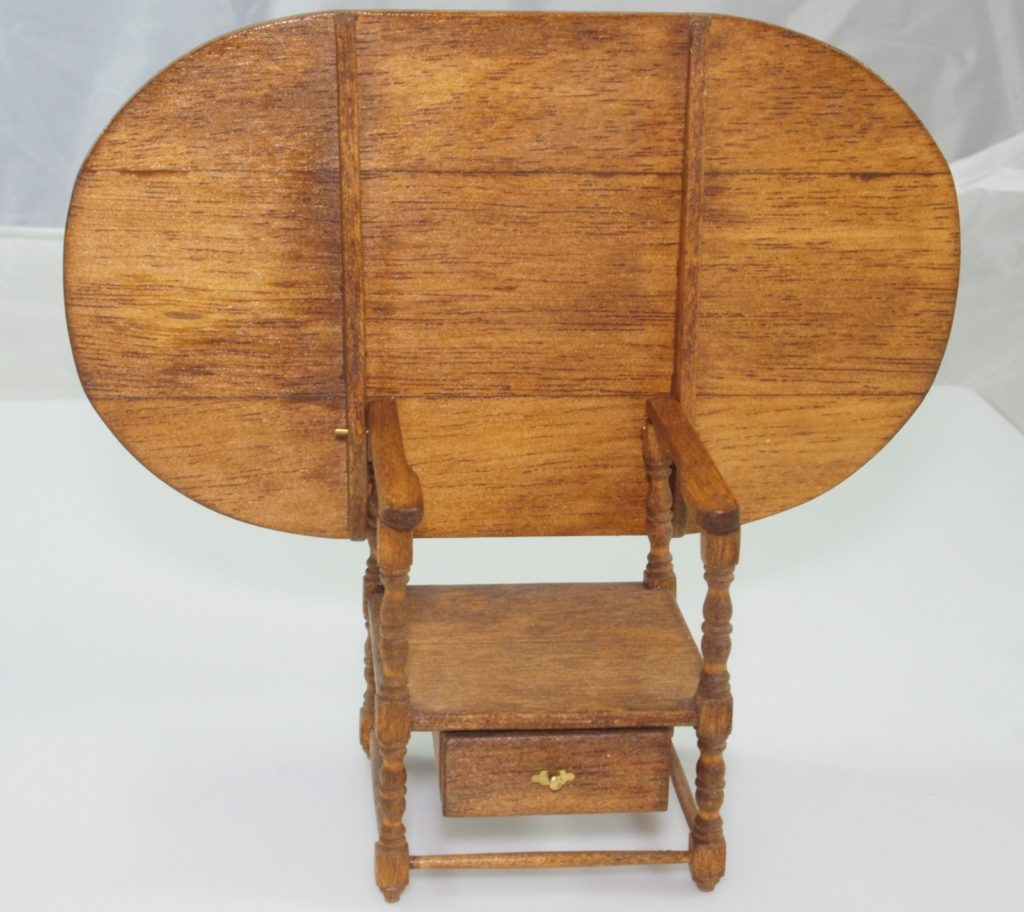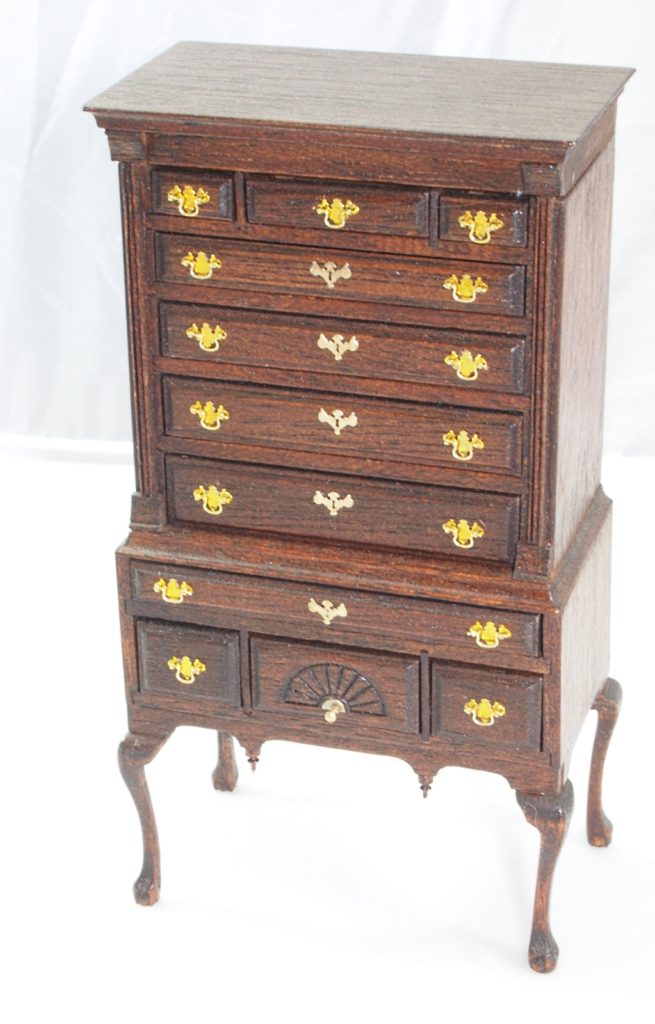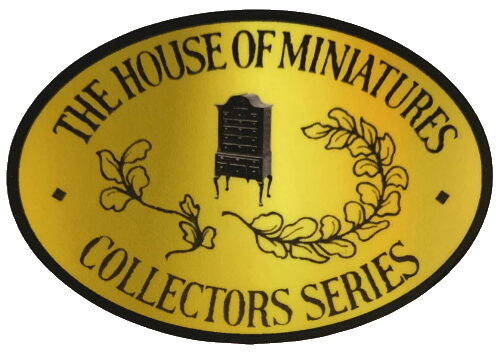
How Authentic?
On every box, package, and advertisement for The House of Miniatures™ you see it. “Authentic Reproductions in Miniature”. As if you will be building a museum piece. What makes these kits authentic reproductions? Is it just ad copy or is it true?

Design and Research
The X-Acto House of Miniatures Collectors’ Series of furniture and accessories have all been carefully researched by specialists through major museums and library collections to assure the highest quality of authenticity in reproduction. Details are extraordinarily accurate to satisfy the most discriminating miniaturist.
The House of Miniatures™ ad copy
Hyperbole aside, THoM maintained high quality standards for both the kits and fine furnishings for mass produced miniatures of the day. In the first several years, The House of Miniatures™ name associated with Colonial Williamsburg. Their kits appeared in articles for The Scale Cabinetmaker. Both were top drawer brands of their time.
The association with Colonial Williamsburg suggests they researched the early kits (mostly Chippendale and Queen Anne) through their museums. It would certainly make sense. The two were collaborating on accessories such as silver settings and miniature art works.
Manufacturing Standards
Although THoM had the parts manufactured in the Far East, they always maintained high design and build standards. Dean Benamy, originator the the Houseworks brand, has said that he had to go to Taiwan and help them find and set up wood-cutting operations that could meet the strict tolerances of furniture kits.
One of the quotes that I saw said that tolerances for the kits were “plus or minus zero”. That is likely impossible to meet with a soft wood. They had to maintain near zero tolerances due to their market. Novice hobbyist would quickly get frustrated if they had to custom fit every piece!
Quality & Shelf Life
In the last few years I’ve built a good number of The House of Miniatures™ kits. THoM manufactured them in the 1970’s and 1980’s, so some of them are 40 years old. The kits contain tiny, softwood parts. In nearly every case the parts still fit together almost perfectly.

One notable exception was a flat top highboy kit. The box was slightly water damaged, but the parts were still in the plastic bag. I wasn’t worried when I bought it, but one of the back pieces was warped. I had to use four bar clamps to hold it flat while the glue dried. The result was that the highboy rocked on the uneven legs. But a little sanding has it standing solidly today.
In a two cases I have had doors with pins for hinges break through the door frame. In one case a cabriole leg was weak and cracked during assembly. Still, as precision models go, THoM kits are about the highest quality I’ve seen, with the possible exception of Tamiya aircraft models of 20 years ago.
My Conclusion
As a lover of Colonial and Federal furniture I have a great appreciation for The House of Miniatures™ kit designs. They are very reminiscent of the common designs of the time period.
As a person of modest means I very much appreciate the opportunity to own some of my favorite furniture at a fraction of the cost of owning the full-sized antique. As a life-long maker of scale models I appreciate the excellent precision, ease of assembly, and customizability of the kits.
So, are they authentic reproductions? In my opinion, the word “reproductions” is a bit of hyperbole. The styles are authentic enough, but a reproduction suggests a near duplication. A better description is models or representations. The word “replicas”, with its more informal connotation, would probably have sufficed.
Do you disagree? Am I being too picky about calling them authentic reproductions? I’d really like to hear your take on the THoM tag line. You are always welcome to comment here or over at the Facebookpage.
Happy mini making!


What is the scale of the furniture? I’m selling several pieces and kits and someone inquired about the scale.
All The House of Miniature Kits are 1:12 scale; one inch to one foot.
I’ve just purchased my first kit Collectors No. 40021 Queen Anne Fire Screen and wondered if there were a way to add a needlepoint to the front of the wood screen. These were commonly used in the late 1700’s but I wouldn’t want to ruin the piece by gluing something on it.
I’d recommend using Museum Wax or something similar so that the needlepoint could be removed easily if desired.
I think that the THoM kits faithfully replicate the style and scale of museum period furniture, but the woods used would have been closer to what real life pieces were made out of when possible. Joints would have used dovetail or mortise and tenon methods. We know sophisticated miniaturia like I’m describing was possible and being produced before the 1970’s since we see these coveted pieces made by artisans decades ago commanding thousands of dollars at auction. Without the social media of today, most of us didn’t have the opportunity to see museum replicas and some of us may not have been aware of their existence. THoM gave the average person access to an affordable, precision kit that could turn out a lovely piece that the home miniaturist could be proud of. If enough thought, time and effort is put into a THoM kit, the quality and fine detail appearance was much better than many of the ready made, factory lines of miniature furniture of the same time. So, for those of us who could not afford to hire artisans (or didn’t have the skills or tools) such as those that created the Thorne Rooms, or silent film star Colleen Moore’s Fairy Castle, we could still put together an impressive collection of miniature furniture that was otherwise mostly unattainable. Lastly, the THoM kits let the beginner miniaturist get familiar with furniture construction. I taught myself how to sew in miniature and one of the best methods to learn, besides practice, is to deconstruct a garment to see the pattern pieces and how they go together. I’ll bet those that have put together a few THoM kits, especially the chairs, now look at a full size furniture piece with different eyes and even how to upholstery it, if they didn’t before!
Thank you for your excellent comment. I like the word you used, “precision”, and I think that is why X-Acto stood for. The House of Miniatures kits did stand up to any mass manufactured minis and can be a starting point for beautiful and detailed pieces. We may be a bit spoiled by the detail in some of the plastic miniatures today or even by a line like Bespaq today, but THoM kits are still about the most fun you can have with a miniatures kit.
I don’t think you are being too particular at all. I have made dozens of THoM kits and am still making them. They are the best of any kits I’ve bought or built. If one tries an old Greenleaf you will find out how fabulous THoM kits are especially! The old Reallife kits are nice but not nearly as pleasant or easy to build as THoM. My favorite story now is how I “kit-bashed” two of the Hepplewhite dining tables together (the central rectangular sections) and rounded the corners to make a table I wanted to seat 14 THoM chairs I’d made.
I especially appreciate the background papers that come with each kit telling of the date and other details. This allows me to create a story around my version that relates to the rooms and houses I put them in.